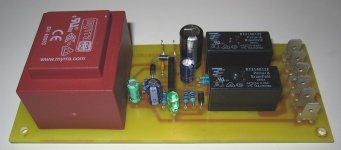I use separated small transformer for the speaker protection. I cost approx. 2Euro, and PCB mounted.
Same here, adapted from a Buildaudioamps schematics.
Jacques
Attachments
delay to ON and instant OFF isolates the speaker before tha amplifier starts to shut down.Do these little guys protect against turn off thump? I have some compression drivers I'd rather not destroy 😉
Instant OFF requires detection of the AC waveform and that loss of AC triggers the circuit.
This can be used for input mute of a Power Amplifier and can also be used as an output mute of a Source.
Instant OFF requires detection of the AC waveform and that loss of AC triggers the circuit.
Or simply use the smallest possible capacitor in the protection PSU. I use 470uF only, followed by common 3 terminal regulator.
Sajti
Can you share files,pcb and schematic?
Not a universal solution. AC detection is the only way to be certain of the fastest possible off.
Not a universal solution.
No, but easy to adopt, and easy to try in practice.
Sajti
Can you share files,pcb and schematic?
Hi Thimios,
Other Audio Related Projects | BuildAudioAmps
For the BOM you have to subscribe (it's free).
Cheers,
Jacques
too slow.
You should use very low Z relays without any capacitor after the rectifier.
PS : others should try to plug and unplug several times their boards to see what happened 😀
You are reading but not assessing the content. Read and understand and discard the chaff.You should use very low Z relays without any capacitor after the rectifier.
PS : others should try to plug and unplug several times their boards to see what happened 😀
Add the time to detect the loss of AC waveform. That amounts to ~10ms.
Add on the electronic delay, maybe another ms.
Add on the relay drop out time, maybe another 2 to 5ms
That totals 12ms to 18ms.
Waiting for the DC on the power supply to sag enough to allow the relay to drop out could take 10000ms, or if you arrange for a very low charge storage one could get down to maybe 1000ms
Too slow, by more than a decade and could be three decades slower to isolate.
Waiting for the DC on the power supply to sag enough to allow the relay to drop out could take 10000ms, or if you arrange for a very low charge storage one could get down to maybe 1000ms
This is simply not true, in this format.
Sajti
You either protect your speaker or you don't, I don't see the point of maybe protecting your speaker
Have you analysed what needs to change to allow the relay to drop out?This is simply not true, in this format.
Sajti
Edit:
You have now analysed, but your estimates are out by a long margin.
You have now analysed, but your estimates are out by a long margin.
Is 70ms is too long? How is it compares to Your 10000ms estimation?
Sajti
Does this look like a viable solution after the smoothing caps ?
A DC Fault Protection Circuit for Audio Amplifiers
Sorry not $5.
A DC Fault Protection Circuit for Audio Amplifiers
Sorry not $5.
Last edited:
- Home
- Amplifiers
- Solid State
- Speaker Protection Kit for under $5

